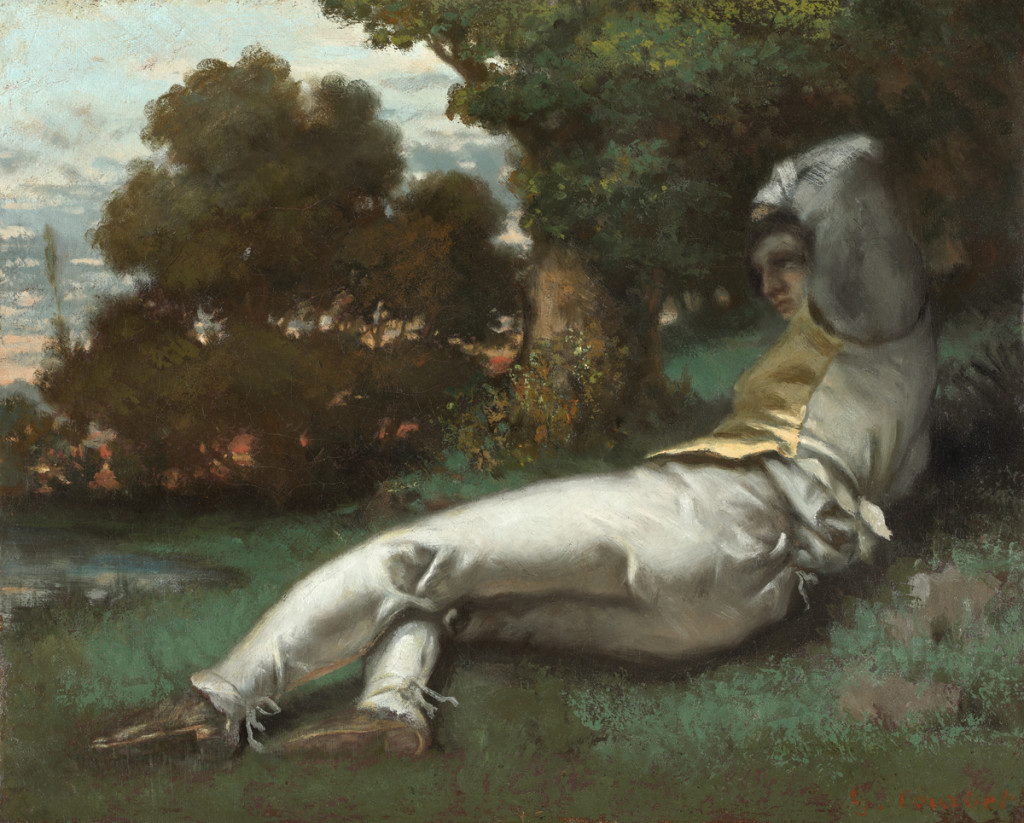Gustave Courbet (Ornans 1819 - 1877 La Tour-de-Peilz)
La Sieste, 1841-42
Oil on canvas, 37.3 x 46 cm
Signed lower right G. Courbet
Provenance:
Paris, auction sale, 17 January 1879, lot 15
Jos Hessel, Paris
Bernheim-Jeune, Paris (no. 21.117)
Bertel O. Steen, Oslo
Private collection, Switzerland
London, Christie’s, auction sale, 29 March 1988, lot 106, repr.
New York, Sotheby’s, auction sale, 20 April 2005, lot 55, repr.
Jan Krugier, Geneva
Exhibited:
Oslo, Kunstnernes Hus, November 1948, no. 4
Courbet. Le retour au Pâys, Ornans, Musée Gustave Courbet, 24 June-15 October 2006, no. 24
Gustave Courbet, Paris, Galeries Nationales du Grand-Palais; New York, The Metropolitan Museum of Art; Montpellier, Musée Fabre, 13 October 2007-28 September 2008, no. 4.
Gustave Courbet (1819-1877) sur les sentiers de l’exil, Geneva, Fondation pour l'écrit du Salon International du Livre et de la Presse, 2012, no. 6
Literature:
Robert Fernier, La vie et l’œuvre de Gustave Courbet, Lausanne and Paris, 1978, I,
p. 14, no. 24, repr. p. 15
Pierre Courthion, L’Opera completa di Courbet, 1985, p. 72, no. 22, repr.
Pierre Courthion, Tout l'œuvre peint de Courbet, Paris, 1987, p. 72, no. 22, repr.
The nimbus attached to Courbet’s name by today’s artists, art historians and collectors has been much enhanced by the multiplicity of critical interpretations of his work and by accounts of his extraordinarily colourful personality.
Modern art historians have frequently pointed out that critical evaluation of Courbet’s œuvre has over-emphasized his reaction, as a Realist, to the negative social impact of the Industrial Revolution – to the neglect of other aspects of his work. This is why they have proposed placing a stronger emphasis on his interest in Romantic Naturalism and Romantic literature.[1] This interest in Romanticism is particularly evident in his early self-portraits.[2]
Laurence des Cars, former curator at the Musée d’Orsay, writes of the twenty early self-portraits as follows: The self-portraits constitute the essence of Courbet’s surviving early works, and as such, they provide a window into his years of training and development as an artist. The references and visual habits established during this time were to become constituent elements in Courbet’s painting […]. In his search for himself, Courbet displayed an impressive degree of self-confidence and aesthetic achievement, engaging in a dialogue with a variety of traditions, both academic and popular but always coherent with respect to his fierce wish to establish a new foundation for himself.
Courbet portrayed himself in a variety of guises and some of his self-portraits even show him dressed up in historical costume. He was anxious to distance himself from academic artists and traditional academic practice, claiming more than once that the only masters he had known were nature and his own talent. He thus rejected tradition to enter ‘the timeless no man’s land of Utopia’.[3] Although he enjoyed presenting a public image of himself as an uncouth provincial, the self-portraits reveal him to be a widely-travelled intellectual who frequently visited the Louvre and other public collections of paintings.[4]
The majority of Courbet’s self-portraits are introspective and depict the artist as a lonely, misunderstood outsider. In the present painting he sees himself as a daydreamer floating between the unconscious and the conscious – in a state of semi-awareness that triggers intuitive artistic activity – object and subject at the same time.[5] The fading light of dusk suffuses the self-portrait as it merges into the shadowy landscape of his native Franche-Comté.
The rich gleam of his stylish clothing is depicted with masterly skill, while his facial features, bathed in deep shadow, are sketchily drawn. His silk waistcoat and white trousers with their ankle ribbons appear in other self-portraits of the period. The close-fitting cut of his clothes heightens the slimness of his figure – Courbet took particular pride in this as a young man.
He wrote emotionally of the Franche-Comté: Pour peindre un paysage, il faut le connaître. Moi, je connais mon pays, je le peins.[6]
Sarah Faunce and Jean-Jacques Fernier have confirmed the authenticity of the painting. It will be included in the forthcoming supplement to the Courbet catalogue raisonné.
[1] Authors like Henri Murger and Alfred de Musset.
[2] Marie-Thérèse de Forges was first to recognize the key role of the self-portrait in Courbet’s œuvre; see Autoportraits de Courbet, exhib. cat., Paris, Musée du Louvre, 1973.
[3] Riot-Sarcey, 1998, p. 116.
[4] Gustave Courbet, exhib. cat., Paris, Galeries Nationales du Grand-Palais; New York, The Metropolitan Museum of Art; Montpellier, Musée Fabre, 2008, pp. 91-9.
[5] This is the state of mind described by Siri Hustvedt in her short essay on the process of falling asleep and the associated switch from subject to object, derived from the ideas of the philosophers Maurice Merleau-Ponty and Edmund Husserl. See Siri Hustvedt, ‘Sleeping/Not Sleeping’, in Living, Thinking, Looking, New York 2012.
[6] Petra ten-Doesschate Chu (ed.), Correspondance de Courbet, Paris 1996 [To paint a landscape you have to know it. I know my country, I paint it].

